HIMEJI CASTLE
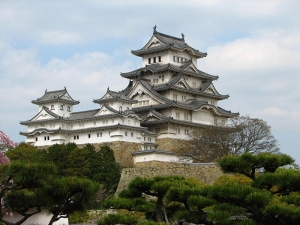 Himeji Castle (Japanese: 姫 路 城, Himeji-jo) is a palace located in the city of Himeji, Hyogo Prefecture, Japan. According to the provincial division of the old days, this palace is located in Harima-no-kunai, Shikito-gun, and Himeji. Enchanting beauty of white plaster walls that dominate the palace make Himeji Castle has another name “white egret bird palace” (Japanese: 白鹭 城, Shirasagi-jo). Himeji Castle is one example of palace architecture of the early relics of the 17th century’s most important.
Himeji Castle (Japanese: 姫 路 城, Himeji-jo) is a palace located in the city of Himeji, Hyogo Prefecture, Japan. According to the provincial division of the old days, this palace is located in Harima-no-kunai, Shikito-gun, and Himeji. Enchanting beauty of white plaster walls that dominate the palace make Himeji Castle has another name “white egret bird palace” (Japanese: 白鹭 城, Shirasagi-jo). Himeji Castle is one example of palace architecture of the early relics of the 17th century’s most important.
Himeji Castle has always escaped the danger of the fire of war and survived the fall of the castle in the hands of the enemy, so the main tower and other buildings of the palace are still much left. The Japanese government set the eight buildings, including the main towers, turrets, and Watari-Yagura at the palace complex as a state heritage. In addition, the manifold-type buildings with a total of 74 buildings inside the palace complex (27 buildings Yagura / Watari-Yagura, building 15 gates, 32 building wall) established as an important cultural heritage.
Himeji Castle is rated as the world’s cultural heritage is very valuable, so that in 1993 UNESCO entered into the Himeji Castle World Heritage Site list for the category of cultural heritage. From a distance looks beautiful with the palace walls are white; Himeji Castle is often used as background locations film dengan ancient Japanese history. The palace is also often used as a substitute location for the other palaces such as Edo Castle.

FOUNDER OF THE PALACE
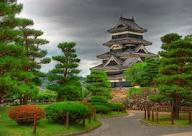 There are records that can be trusted that the Himeji Castle was first built in 1346 at the time of the Palace of the North-South Palace by son shogun Akamatsu Norimura (Enshin) called Akamatsu Sadanori in mountain locations Hime located in the northern city of Himeji.
There are records that can be trusted that the Himeji Castle was first built in 1346 at the time of the Palace of the North-South Palace by son shogun Akamatsu Norimura (Enshin) called Akamatsu Sadanori in mountain locations Hime located in the northern city of Himeji.
There are opinions that say, in the days of clan Akamatsu, “palace” that was mentioned at that time was small, so it is more appropriate if called fortress. Building on a large scale that can be called as a “palace,” was built in the 16th century by Kuroda Shigetaka Kodera of the ruling clan in the lowland areas of Harima.
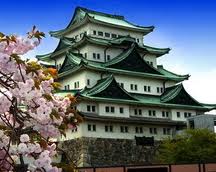 After that, in 1580 the right hand Nobunaga Oda Hideyoshi Hashiba named (later known as Toyotomi Hideyoshi) chooses Himeji Castle as a centre of power to govern Harima. The palace then repaired by following the model of a medieval castle in order to look nice from the outside.
After that, in 1580 the right hand Nobunaga Oda Hideyoshi Hashiba named (later known as Toyotomi Hideyoshi) chooses Himeji Castle as a centre of power to govern Harima. The palace then repaired by following the model of a medieval castle in order to look nice from the outside.
Unfortunately, the remaining palace buildings and architectural heritage can be seen now is not the architectural legacy from the time of Toyotomi Hideyoshi, but from
the time of “shogun country west” Ikeda Terumasa who is the husband of the daughter of Tokugawa Ieyasu.
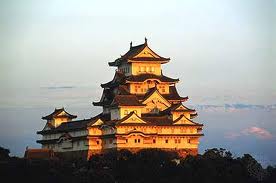
Ikeda Terumasa took 8 years to complete the Himeji Castle which was built in 1601. Minister Ikeda daimyo family named Iza Tadazumi appointed as leader of construction (普 请 奉行, fushin bugyō?) And Sakurai Genbei as head carpenter. Construction of the palace mobilizes workers who came from residents around the palace. According to the calculation of the Japanese way, the construction of the palace is estimated to need a handyman with a total power between 40 million to 50 million working days.
STRUCTURE OF THE BUILDING
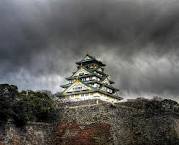 Himeji Castle is a palace built on top of the mountain in the middle of the plain (model hirayamajiro palace). Centers exist in mountain Hime palace with the main tower which was founded exactly in the middle. Surrounding area is flat land also incorporated into the palace.
Himeji Castle is a palace built on top of the mountain in the middle of the plain (model hirayamajiro palace). Centers exist in mountain Hime palace with the main tower which was founded exactly in the middle. Surrounding area is flat land also incorporated into the palace.
Overall, Himeji castle model building using the arrangement Teikaku spiralyang shaped rotating counterclockwise with clockwise 3 times, with starting point in the northern mountain Hime. The first round is called Uchiguruwa (zone in), the second round called Nakakuruwa (middle zone), and a third round is called Sotokuruwa (outer zone). Now all that was left was the living zone which is a complex Uchikuruwa Himeji Castle today. Other zones areas harnessed into Sogamae (most outer territory palace) which encircle the city around the palace.
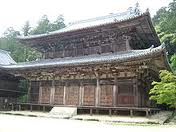 Uchikuruwa inner zone consists of five layers, namely Honmaru (main area), Ninomaru (secondary area), Sannomaru (the tertiary), Nishinomaru (western region), and Demaru (keepers of the palace office). In the zone Uchikuruwa there are also several other zones, namely Mizukuruwa, Koshikuruwa, and Obikuruwa. Each zone is separated out in detail by the gates of which are named based on the composition of Hiragana “i-ro-ha”, such as I-no-Mon, Ha-no-Mon, and so on.
Uchikuruwa inner zone consists of five layers, namely Honmaru (main area), Ninomaru (secondary area), Sannomaru (the tertiary), Nishinomaru (western region), and Demaru (keepers of the palace office). In the zone Uchikuruwa there are also several other zones, namely Mizukuruwa, Koshikuruwa, and Obikuruwa. Each zone is separated out in detail by the gates of which are named based on the composition of Hiragana “i-ro-ha”, such as I-no-Mon, Ha-no-Mon, and so on.
The large field that is now in front of the building, Himeji Castle, once the region Sannomaru, while Zoo Himejimenempati Demaru parts. In the region there are little Nishinomaru only remaining buildings, one of whom tower named Kesho-Yagura.
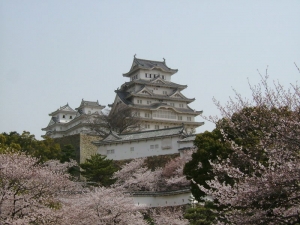 Construction of the palace, led by Ikeda Terumasa done exactly in between the War and the Battle of Sekigahara Winter-Summer Osaka (Osaka no eki), therefore the palace was designed with the intent to use in real battle. Also at the same court appearance should look beautiful and majestic as a symbol of greatness “shogun country west” which became the nickname Ikeda Terumasa.
Construction of the palace, led by Ikeda Terumasa done exactly in between the War and the Battle of Sekigahara Winter-Summer Osaka (Osaka no eki), therefore the palace was designed with the intent to use in real battle. Also at the same court appearance should look beautiful and majestic as a symbol of greatness “shogun country west” which became the nickname Ikeda Terumasa.
After Himeji Castle is built, in Japan there is no longer building large palaces such as Himeji Castle, because in 1615 the Tokugawa shogunate government issued a decree “One country one palace” (Ikkoku-Ichijo-rei). Construction of a new palace, the restoration and repair some of the palaces becomes impossible without a permit issued by the Tokugawa Shogunate, except Edo Castle and Nagoya Castle is the residence of the Tokugawa clan.
In the northern mountain wilderness remaining Hime-haraseirin Himeyama that has existed since before the palace was built. According to the news, the underground tunnel from the exit Honmaru have the emergence in the middle of the forest-haraseirin Himeyama, but until now no one can find it.

In the west of the mountain river flowing Hime Senbagawa a useful addition to the transport path, partly diverted river flows into the castle moat.
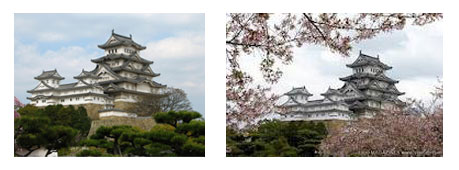
Hall and the Gate
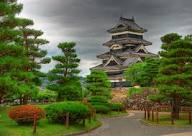 The halls of the palace was designed similar to labirinyang sharply twisting, widened and narrowed in one place elsewhere, with the intention that the enemy cannot move forward in a straight line towards the main tower. Winding hallway Himeji Castle using the composition of Hideyoshi era buildings at the same time optimally utilize the existing topography.
The halls of the palace was designed similar to labirinyang sharply twisting, widened and narrowed in one place elsewhere, with the intention that the enemy cannot move forward in a straight line towards the main tower. Winding hallway Himeji Castle using the composition of Hideyoshi era buildings at the same time optimally utilize the existing topography.
Some gates also made very narrow, so narrow that only can pass people one by one. In addition, the gates are built in places unexpected and its buildings are made that are not easily seen by the enemy, with the intention that the enemy stuck in the gate and could not continue the attack. One tactic, the enemy were herded into a dead end alley and then clamped with an attack from either side so that the enemy is so topsy-turvy confusion.
 If you get into the castle through the ramp (located on the north Sannomaru) and walk straight through the gates after Mugi-no-Mon, then the road that passes through the gate I-no-Mon, Ro-no-Mon, and Ha- no-Mon will likely look like a shortcut to the main tower. But really, the road to the main tower could be closer if after passing the gate Mugi-no-Mon, immediately turn right past the low-roofed small door hidden between walls of rock.
If you get into the castle through the ramp (located on the north Sannomaru) and walk straight through the gates after Mugi-no-Mon, then the road that passes through the gate I-no-Mon, Ro-no-Mon, and Ha- no-Mon will likely look like a shortcut to the main tower. But really, the road to the main tower could be closer if after passing the gate Mugi-no-Mon, immediately turn right past the low-roofed small door hidden between walls of rock.
Ru gate-no-Mon is the gateway Uzumimon model that can be hidden with heaps of soil, sand, and gravel so that the enemy cannot see it. Surely the enemy will be surprised by a sudden attack from an invisible gate.
In the hallway toward the Ni-no-mon of the Ha-No-Mon, enemies can only move forward without being able to see those who stand behind it (must be attacked from behind), let alone the gates of Ha-no-Mon a metal door that was really narrow. Suppose that can get away too, without detour once again under the main tower complex, the enemy will not get to the main tower.
Tower Palace
The main tower at Himeji Castle is one of the towers of the palace is still the original construction of the building, outside the palace is still the same appearance as the time in the Edo period, so that no one else if the palace was used as a symbol of the city of Himeji.
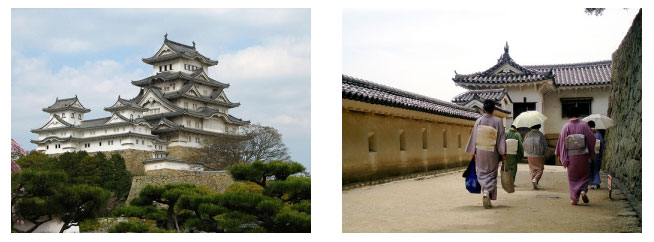
On top of that foundation is built on top of the mountain Hime, there are five main tower roofed apartment building which is a seven storey (6 level to the upper floors and 1 underground), and 3 building turrets (West Tower, Tower Inui, and the East Tower ). 2 flat-roofed building called Watari-Yagura (literally: “the tower to cross”) is used to connect a single tower with another tower.
Use of Watari-Yagura as building liaison between the tower called Renritsu.Berdasarkan methods and model development period of construction, the tower of Himeji Castle is classified as a model watchtower late period (Japanese: 期望 楼型, goki Horo-gata)
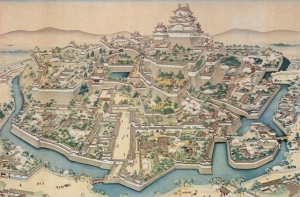 The entire tower building is intended to shelter from enemy attacks so that the wall was built to be fireproof, anti-fire and bullet proof using white plaster shikkui which also adds to the beauty of the palace.
The entire tower building is intended to shelter from enemy attacks so that the wall was built to be fireproof, anti-fire and bullet proof using white plaster shikkui which also adds to the beauty of the palace.
The opposite of white Himeji Castle, the Palace Okayama nicknamed “Crow Castle” because of the palace walls made of boards like the colour Black. Himeji Castle construction done during the transition period they used wall board. (For example, Okayama Castle) used white stucco Shikkui to the outside wall palace.
Tower of Himeji Castle is rich in architectural diversity when compared with other castle towers in Japan. Kara-hafu is a large ridge that forms a smooth curve, while the Chidori-shaped ridge hafu is an open book ditelungkupkan. Variation Chidori-hafu with a multi-tiered roof is called O-Chidorihafu.
 Just below the second layer hafu Kara-facing to the south looks gigantic trellis conspicuous. Katomado is a unique window shaped like a bell located in the West Tower and Tower Inui. Window Katomado model can also be found in Hikone Castle and several other palaces belonging to the model tower steeple final period.
Just below the second layer hafu Kara-facing to the south looks gigantic trellis conspicuous. Katomado is a unique window shaped like a bell located in the West Tower and Tower Inui. Window Katomado model can also be found in Hikone Castle and several other palaces belonging to the model tower steeple final period.
The main tower height as measured from the foundation of the tower is 15.18 meters, while if the height of the tower foundations accounted for the overall height of the main tower is 46 meters 36 cm (measured from the south side of the tower).
According to estimates, the weight of the tower which is there now is about 5,700 tons, whereas the previous weight reaches 6200 tons. Weight tower is reduced thanks to the massive restoration times Showayang replace tile with lighter materials. The main tower is now used to exhibit a wide range of items related to Himeji Castle.
Nishinomaru
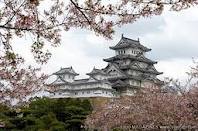 The remaining buildings in the area Nishinomaru Watari-Yagura just stay connected by Nagatsubone (a row of rooms along the 300-meter), and Kesho-yagurayang located at the northernmost tip. The rooms are in Nagatsubone formerly used by the maid as a bedroom.
The remaining buildings in the area Nishinomaru Watari-Yagura just stay connected by Nagatsubone (a row of rooms along the 300-meter), and Kesho-yagurayang located at the northernmost tip. The rooms are in Nagatsubone formerly used by the maid as a bedroom.
Honda built towers Tamadasa Kesho-Yagura after from Kuwana in Ise (now Mie Prefecture region). The cost to set up towers Kesho-Yagura was taken from Princess Mon dowry of 100,000 koku. As the name implies, in the tower Kesho-Yagura (Japanese: 化妆 橹, literally: “the tower dressed”) found the remains of Princess Mon-owned cosmetic restoration was held during the World War II.
Princess Nishinomaru Sentinggal in the territory occupied dwelling house called Chūshomaru (another name: Tenjuinmaru, built in 1618) or a big house Musashino-Goten Sannomaru contained in addition to, but unfortunately now there is no more left of the building.
Koshikuruwa and Mizukuruwa
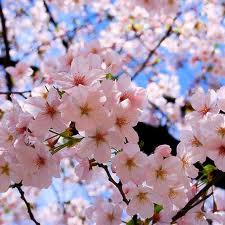 The north side of the main tower in the Koshikuruwa region. In this region there are wells and storehouses of rice and salt are intended to supply at the palace in a state of siege. In peacetime, the food is stored in warehouses around the mountain Hime.
The north side of the main tower in the Koshikuruwa region. In this region there are wells and storehouses of rice and salt are intended to supply at the palace in a state of siege. In peacetime, the food is stored in warehouses around the mountain Hime.
Land under palace tower comprises a layer of hard rock so that water wells cannot be dug in this location, but excavated in the region Mizukuruwa with gates that are built to keep the supply line between the tower and the palace gate Koshikuruwa. In the region Mizukuruwa, the gates were named according to serial number, start-Ichi Mizu Mizu-to-Go Mon-Fri.
Within the Koshikuruwa, precisely on this side of the gate Ho-no-Mon from the ground that there is a wall called the wall Aburakabe hardened. This wall intentionally left bare brown soil with natural colour, different from the other walls are plastered white Shikkui. There are various theories that try to explain the construction methods and reasons Aburakabe wall is made as it is, but there are also opinions that say this wall relics of Hideyoshi.
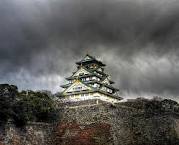 Harakirimaru
Harakirimaru
In the southeast of the main tower there is a tower-Yagura Obikuruwa having Harakirimaru sinister epithet. The nickname was born because the atmosphere is gloomy and dark in the vicinity of existing wells in the area Koshikuruwa. Not surprising considering this place was prepared as a hiding place to surprise the enemy with a hail of gunfire. Never existed in the record that at the ritual harakiri Harakirimaru never took place, moreover there can be no innocent people in the neighbourhood of this palace to be up to commit seppuku.
